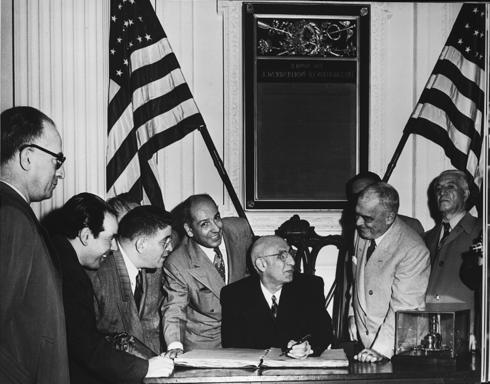On November 24, 2013, the 5+1 powers and Iran finally reached a first-stage agreement over Iran’s nuclear program. Does this agreement mean that Tehran and Washington can now move beyond the decades of mistrust and work together, or are the two countries doomed to repeat the mistakes of the past?
In some ways, the nuclear deal echoes an earlier tipping point in US-Iran relations: the August 19, 1953 coup ousting Prime Minister Mohammad Mossadeq, which came after years of attempted negotiations over oil nationalization, and which proved a turning point for American-Iranian relations and US foreign policy beyond Iran.
In the wake of WWII, Washington’s fears of the Soviet Union’s burgeoning ambitions led the U.S. to adopt a strategy of containment, which extended itself to Iran. Meanwhile, Mossadeq sought to further his own nationalist project. His efforts to free Iran from imperialism and colonialism culminated in his move to nationalize the Anglo-Iranian Oil Company in 1951.
Mossadeq had fairly good relations with Washington during the Truman administration, and apparently believed that justice and anti-imperialism would trump historical alliances and political expediencies. However, his idealism led to claims that he refused to shut down propaganda outlets run by the Soviets and other opposition factions, even after mass demonstrations in February 1953. The newly-inaugurated Eisenhower Administration, which publicly expressed support for a negotiated settlement, agreed to go along with the British in their attempt to overthrow Mossadeq.
Mossadeq’s miscalculation was more than just a matter of naivete, however. He had to withstand serious criticism from both far-left and far-right in Iran, which hampered his ability to work towards an acceptable resolution for all. Today, both Barack Obama and Hassan Rouhani face similarly challenging domestic situations.
The events of August 16-19, 1953 remain shrouded in mystery and intrigue; however, while the architects of the coup certainly included a variety of domestic factions as well as the obvious international powers, Iranians still consider the Americans to be the primary antagonist. The “crime” was one of the justifications for the 1979 storming of the US Embassy, referred to as the “den of spies”. Whether accurate or not, this perception — that an external force was meddling in Iran’s internal affairs — certainly helped Iran’s first Supreme Leader, Ayatollah Ruhollah Khomeini make a name for himself through his critique of American misdeeds.
The legacy of this sentiment is that President Rouhani faces serious opposition from conservative factions in the Iranian political establishment, who have made anti-Americanism a cornerstone of their political discourse. The current Supreme Leader, who has the final say on all matters in Iran, is not the only force that could turn this discourse into action. There are a variety of ways, for example, in which Parliament or the Revolutionary Guards could derail any potential agreement.
Similarly there are groups in the US opposed to the Obama Administration, and therefore by default to any deal that the US President wishes to make. The Israeli Government is also opposed to an agreement with Iran, even if this view is not universal among the country’s security establishments.
There is a risk that, as in 1953, one of the parties may get cold feet or abruptly insist on different terms. In January 1953, US Ambassador to Iran Loy Henderson complained to the State Department that Mossadeq had suddenly changed his demands, replacing the word “arbitration” in the draft agreement with the very different term “adjudication”. While Henderson recommended that the US continue to attempt to resolve the dispute through diplomatic means, President Eisenhower and the Dulles brothers — heads of the State Department and the CIA — were able to take advantage of the development as a pretext for a coup.
A significant factor leading to the failure of the oil nationalization negotiations was the replacement of center-left British and American governments with conservative governments. The new administrations were less flexible in negotiations than their predecessors, and more inclined to intervene extra-judicially. The resounding defeats of hawkish candidates in both recent American and Iranian presidential elections gives one hope that a permanent deal is possible, but there are still many obstacles to face.
Just as in 1953, there are many factors which could prevent a lasting agreement between the United States and Iran. The greatest threat is the uncertainty stemming from domestic instabilities in both Tehran and Washington. Though both new Presidents won the popular vote, opposition groups still retain significant power in both countries, and have the power to reverse the modest gains made in negotiations.
Ultimately, the thaw in Iran-US relations that led to the November nuclear agreement is far too tenuous to withstand last-minute changes in position from either side. There is no room for brinksmanship over a hard-won agreement that is already teetering on the edge.
About the author: Morgan Carlston is an MA candidate in Middle Eastern History at Tel Aviv University. He received his Bachelor of Arts degree in Geography from Macalester College, and blogs on Iran and the Middle East at Persophilia.blogspot.com
(Featured image: Prime Minister Mohammed Mossadegh of Iran signing the guestbook at Independence Hall in Philadelphia with Mayor Bernard Samuels.)

